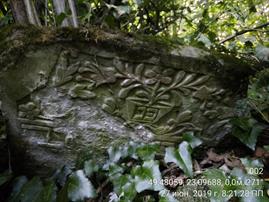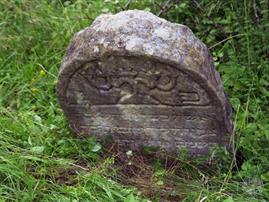Stara Sil
Zolochiv district, Lviv region
Year - Total Population - Jews
1765 - ? - 229
1880 - 1,347 - 416
1890 - 1,343 - 378
1900 - 1,430 - 340
1910 - 1,506 - 348
1921 - 1,170 - 211
1765 - ? - 229
1880 - 1,347 - 416
1890 - 1,343 - 378
1900 - 1,430 - 340
1910 - 1,506 - 348
1921 - 1,170 - 211
Sources:
- Pinkas Hakehillot Polin: Encyclopedia of Jewish Communities, Poland, Volume II, page 377-378, published by Yad Vashem, Jerusalem. Translated by Jerrold Landau, JewishGen, Inc.
Photo:
- European Jewish Cemeteries Initiative. Published by Center for Jewish art
- Pinkas Hakehillot Polin: Encyclopedia of Jewish Communities, Poland, Volume II, page 377-378, published by Yad Vashem, Jerusalem. Translated by Jerrold Landau, JewishGen, Inc.
Photo:
- European Jewish Cemeteries Initiative. Published by Center for Jewish art
Stara Sуl (ukr. Stara Sil, Стара Сіль) is first mentioned as an urban settlement in 1421. Its residents were primarily occupied in agriculture and salt mining. Regarding the origins of the Jews of Stara Sуl: a royal charter of rights was given to the residents of the city of Stara Sуl in 1615, stating that the Jews were forbidden from owning private houses and from working in agriculture and commerce.
Despite this ban, Jews continued to live in the city, and were economically active. Sources from 1617 speak of the “Jew Moshe of Stara Sуl” who apparently worked in salt mining and salt trade.
In 1701–1704, Shmuel Chajmowicz was the primary lessee of the manufacture and trade of salt in the place. He exported 18,00 barrels of salt annually to the commercial centers of Poland.
In 1776, a large fire destroyed a sizable portion of the houses of the city. Many Jewish homes were also damaged in the fire.
For a time, Jews were forbidden from building new houses.
At the end of the 18th century, the number of permanent Jewish residents of Stara Sуl declined to 21. However, a strengthening of the economic activity of the Jews of the city began in the middle of the 19th century, and the size of the community grew noticeably. They continued in the salt business, and broadened their fields of commerce to include agricultural products.
Flourmills and sawmills in the town and the area were under Jewish ownership.
In the 1860s, Rabbi Avraham Moshe the son of Rabbi Efraim Tzvi served as the rabbi of the community. Rabbi David the son of Rabbi Yehoshua Reis occupied the rabbinical seat in 1870. Rabbi Pinchas the son of Rabbi Shimon–Elimelech Rimalt served as rabbi of Stara Sуl at the beginning of the 1890s.
After the First World War, Rabbi Ephraim Langnaur served there. He also served as the rabbi of several other cities of the region.
Between the two world wars, the Jews of Stara Sуl were in a perpetual economic crisis. The government monopoly of salt manufacturing and marketing affected the primary source of livelihood of the members of the community. Many families left the place and moved to larger settlements.
Ten shekels were sold in Stara Sуl before the 14th Zionist Congress. In 1927, only five were sold. For the 17th Zionist Congress in 1939, 14 votes were cast for the General Zionists, and 1 for the Revisionists.
Stara Sуl was under Soviet rule from 1939–1941. The Jews suffered the usual tribulations of that era.
The Germans entered Stara Sуl on July 2, 1941. Even prior to their entry, after the Soviets evacuated the district at the end of June, the Ukrainians began to oppress the Jewish population. A number of Jews who were “accused of Communism” were removed from the settlement, and their traces disappeared. They were apparently murdered by the Ukrainian policemen.
Hunger and illness were the lot of the Jews of Stara Sуl in the autumn and winter of 1941–1942. German policemen would arrive from Stary Sambor from time to time, pillage the property of the Jews, and snatch them for forced labor. In the wake of this constant oppression, Jewish families began to abandon the place and join their relatives in the larger communities of Stary Sambor and Sambor.
In March 1942, a group of Jews was deported to the Sambor Ghetto. The last members of the community were moved from Stara Sуl to Sambor at the beginning of August 1942, where they joined those who were deported to the Belzec Death Camp.
Despite this ban, Jews continued to live in the city, and were economically active. Sources from 1617 speak of the “Jew Moshe of Stara Sуl” who apparently worked in salt mining and salt trade.
In 1701–1704, Shmuel Chajmowicz was the primary lessee of the manufacture and trade of salt in the place. He exported 18,00 barrels of salt annually to the commercial centers of Poland.
In 1776, a large fire destroyed a sizable portion of the houses of the city. Many Jewish homes were also damaged in the fire.
For a time, Jews were forbidden from building new houses.
At the end of the 18th century, the number of permanent Jewish residents of Stara Sуl declined to 21. However, a strengthening of the economic activity of the Jews of the city began in the middle of the 19th century, and the size of the community grew noticeably. They continued in the salt business, and broadened their fields of commerce to include agricultural products.
Flourmills and sawmills in the town and the area were under Jewish ownership.
In the 1860s, Rabbi Avraham Moshe the son of Rabbi Efraim Tzvi served as the rabbi of the community. Rabbi David the son of Rabbi Yehoshua Reis occupied the rabbinical seat in 1870. Rabbi Pinchas the son of Rabbi Shimon–Elimelech Rimalt served as rabbi of Stara Sуl at the beginning of the 1890s.
After the First World War, Rabbi Ephraim Langnaur served there. He also served as the rabbi of several other cities of the region.
Between the two world wars, the Jews of Stara Sуl were in a perpetual economic crisis. The government monopoly of salt manufacturing and marketing affected the primary source of livelihood of the members of the community. Many families left the place and moved to larger settlements.
Ten shekels were sold in Stara Sуl before the 14th Zionist Congress. In 1927, only five were sold. For the 17th Zionist Congress in 1939, 14 votes were cast for the General Zionists, and 1 for the Revisionists.
Stara Sуl was under Soviet rule from 1939–1941. The Jews suffered the usual tribulations of that era.
The Germans entered Stara Sуl on July 2, 1941. Even prior to their entry, after the Soviets evacuated the district at the end of June, the Ukrainians began to oppress the Jewish population. A number of Jews who were “accused of Communism” were removed from the settlement, and their traces disappeared. They were apparently murdered by the Ukrainian policemen.
Hunger and illness were the lot of the Jews of Stara Sуl in the autumn and winter of 1941–1942. German policemen would arrive from Stary Sambor from time to time, pillage the property of the Jews, and snatch them for forced labor. In the wake of this constant oppression, Jewish families began to abandon the place and join their relatives in the larger communities of Stary Sambor and Sambor.
In March 1942, a group of Jews was deported to the Sambor Ghetto. The last members of the community were moved from Stara Sуl to Sambor at the beginning of August 1942, where they joined those who were deported to the Belzec Death Camp.

- Home
- Shtetls
- Vinnytsia region
- Volyn region
- Dnipro region
- Donetsk region
- Zhytomyr region
- Zakarpattia region
- Zaporizhzhia region
- Ivano-Frankivsk region
- Kyiv region
- Kropyvnytskyi region
- Luhansk region
- Lviv region
- Mykolayiv region
- Odessa region
- Poltava region
- Rivne region
- Sumy region
- Ternopil region
- Kharkiv region
- Kherson region
- Khmelnytskyi region
- Chernihiv region
- Chernivtsi region
- Cherkasy region
- Crimea
- Synagogues
- Cemeteries
- Objects & guides
- Old photos
- History
- Contact
Jewish towns of Ukraine
Jewish towns of Ukraine
My shtetl
My shtetl
Donate

